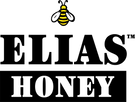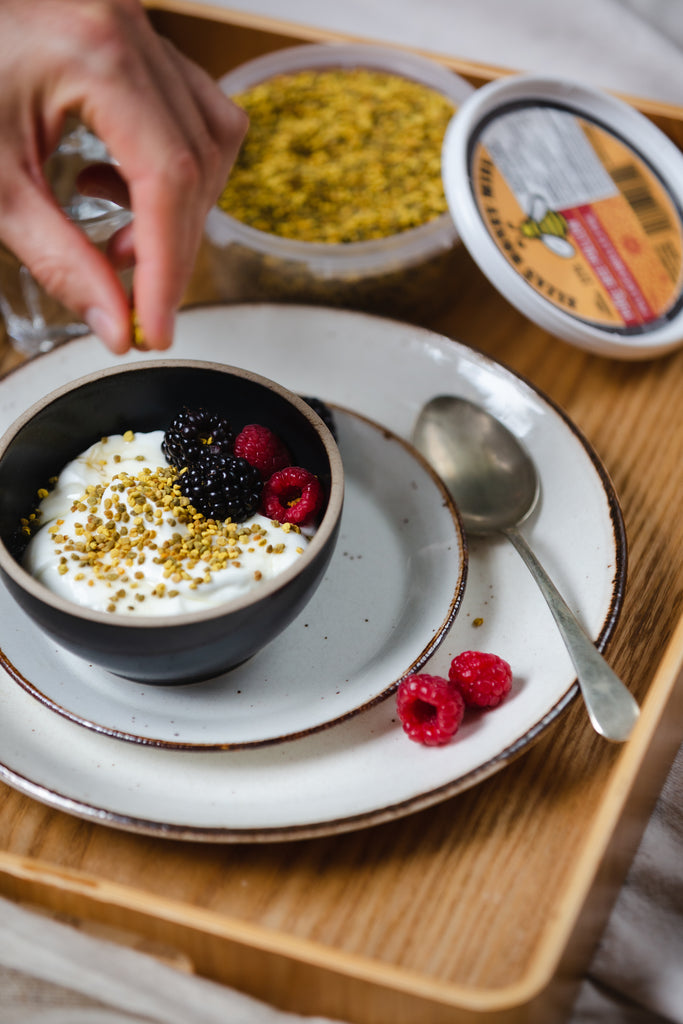What is Bee Pollen?
In short - Bee Pollen is the main source of healthy fats, proteins and nutrition to nurse bees, baby bees and drone bees. Studies have shown that bee pollen contains over 250 biologically active substances, including proteins, carbs, lipids, fatty acids, vitamins, minerals, enzymes and antioxidants, and is approximately 35% pure protein by composition.
Bee pollen consists of the powdery substance that bees collect from the plants and flowers on their legs and bodies to take back to the hive as a food source.

Once the bees return home with the pollen they collect, it is covered with a small amount of beeswax and honey by other bees. This is called “bee bread,” and it’s the main protein source for the bees in the colony.
Because the pollen grains are collected from many different types of plants, bee pollen varies in shape, color, and nutritional content. Although bees normally collect pollen from just one type of a plant at a time, sometimes they will gather it from many different flowers.
Benefits of Bee Pollen
Here are some of the other health benefits bee pollen is known to have:
- Nutrients. Bee pollen is known to contain the essential macro-nutrients: healthy fats, proteins and carbohydrates. It also contains trace minerals, vitamins, enzymes and amino acids.
- Antioxidants. Certain chemicals present in the body called “free radicals” can cause cancer and type 2 diabetes. Bee pollen contains significant amounts of antioxidant substances that help counteract these free radicals.
- Protection against liver damage. One 2013 study showed bee pollen helpful in healing liver damage in rats under specific research circumstances. (Source)
- Anti-inflammatory properties. Allergies are caused by inflammation, and consuming local pollen may help with mitigating the effects of seasonal allergies. Bee pollen has also shown to help reduce general inflammation and some specific genetic mutations. (Source)
- Relief for breast cancer patients. One small 2015 study showed that pollen can reduce hot flashes, night sweats, and other symptoms experienced by breast cancer patients during treatment. (Source)
- Wound healing. A 2016 scientific study showed an ointment made from bee pollen was helpful in promoting healing from burns. (Source)
How to Eat Bee Pollen

Since there is a small chance you may be allergic to pollen, it’s best to check with your health practitioner to see if bee pollen is a suitable supplement to your diet. When given the green light, it’s go time!
If it’s your first time eating Bee Pollen, it’s recommended that you start with a very small dose and you work your way up from there. This is to ensure that there is no allergic reaction and your body can tolerate it.
- Place one Bee Pollen Granule under your tongue
- Wait for it to dissolve completely.
- If you experience no reactions you can increase your daily dosage by a few granules per day for about a month.
- After a month, you should feel fairly confident to consume bee pollen in all kinds of ways (see below).
With it’s relatively neutral taste, bee pollen works in almost anything!
You can use it as a topping on cereal or a yogurt parfait with fresh berries, or mix it into a hearty bowl of oatmeal. You can also use it as a crunchy topping on salads, toast, poke bowls or buddha bowls! Or if you’re really looking to maximize its restorative effects, blend it in a protein shake or smoothie.
You can also just eat it by the spoonful, the taste of bee pollen is While individual tastes vary, bee pollen has a generally sweet and flowery taste. Its texture is crunchy and powdery.
How to Buy Bee Pollen
When looking to buy bee pollen is extremely important to know the source. Locally harvested using specialized pollen traps, Elias Honey’s Bee Pollen is definitely the go-to for taste, quality, and, of course, to support local!





